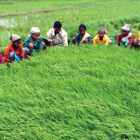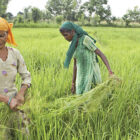Climate Change: Our worst nightmare is yet to appear in our dreams.
My grandfather, Balram Jakhar was amongst the pioneers of citrus plantation in north India, in the mid-1950s. In 1972, when he first became a member of the Punjab’s legislative assembly, he had promised to transform the bleak near-arid barren sand dunes into California. As his days came to a close, he loved to talk of the promise and similarities of the much-diversified farming in the area, when asked about it. We farm in village Maujgarh, in the Khuiansarwar block of district Fazilka in Punjab.












